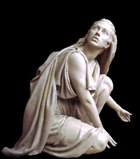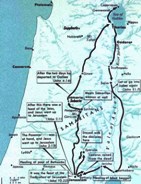Resurrection – tragedy and triumph
Questions for Bible study groups
- Why did the women go to the tomb?
- What did the women find at the tomb?
- What did the women do when they saw the empty tomb?
In brief: Notice that the Resurrection itself is never described in the gospels. There was no-one there to see it. Instead, the evangelists tell us how Jesus’ resurrection was discovered. They knew they were describing something incredible, and they wanted to do so in as credible a way as possible – hence the witnesses, people who were there at the scene.
The witnesses were specific people – Mary Magdalene, John, Peter, etc. As with all eye-witness accounts there are differences in details, but the main points are clear.
Why did the women go to the tomb?
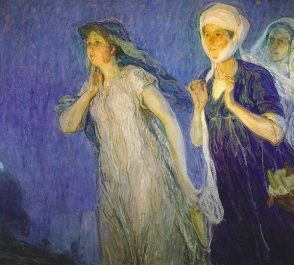 In the ancient world it was women, usually family members, who washed a corpse and laid the body out for burial. In this case, the task was given to Mary Magdalene, Mary the mother of James, and Salome. They had cared for him in life, and now they would care for him in death.
In the ancient world it was women, usually family members, who washed a corpse and laid the body out for burial. In this case, the task was given to Mary Magdalene, Mary the mother of James, and Salome. They had cared for him in life, and now they would care for him in death.
The normal thing was to wash and clean the body first. In Jesus’ case, this would have been a difficult task, since his body was heavily matted with dried blood. In the second stage of this cleansing, the women would have added spices to water and gently smoothed this liquid over the body. Then they would bind the arms and legs so they were held firmly, and wrap the whole body around with a long strip of linen cloth – the shroud. This was the simple, gentle act performed by women for the people they loved.
And this was what the two Marys and Salome expected to do.
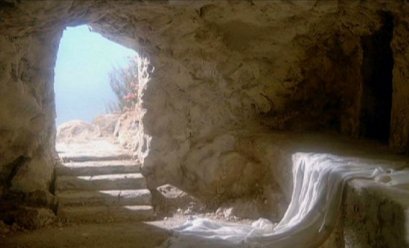 But when they reached the tomb, they were greeted by an unexpected sight. The stone that covered the entrance of the tomb was no longer in place, but rolled sideways so that anyone might enter the tomb.
But when they reached the tomb, they were greeted by an unexpected sight. The stone that covered the entrance of the tomb was no longer in place, but rolled sideways so that anyone might enter the tomb.
They were frightened and astonished by this unexpected sight. When they had left the tomb on the evening before the Sabbath, they had placed Jesus’ dead body on one of the stone slabs inside the tomb, and then the entrance to the tomb had been firmly closed.
But now the body was missing, with no sign of where it had gone.
Read the blue Gospel text at bottom of page
What did the women find at the tomb?
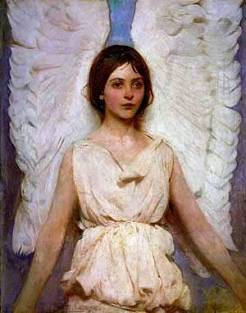 A normal reaction would have been to think that someone had stolen the body – Peter might have done it. He had a reckless streak and was ashamed of his denial of Jesus at the house of Caiphas.
A normal reaction would have been to think that someone had stolen the body – Peter might have done it. He had a reckless streak and was ashamed of his denial of Jesus at the house of Caiphas.
But the body had not been stolen by anyone, friend or foe, and the women were perplexed.
The answer came swiftly. In the place where the women expected to find Jesus’ body, there were instead one (Luke says two) beings whom the gospels call ‘angels’, dressed in the white garments associated with heavenly beings.
This is a difficult concept for modern readers to understand. ‘Angels’ do not form part of our way of thinking. The modern reader can perhaps better understand this gospel passage if they think of angels not as messengers from God, but as the message itself, given and accepted.
- Something in their experience of this moment convinced the women that not only was Jesus not there, which they could plainly see, but that he had undergone some transformative experience that meant he was alive, even though they had known him to be truly dead
- if they wanted to see him (which of course they did) they should look for him not in Jerusalem, but in the rural villages of Galilee where he came from. There, away from the sophisticated city of Jerusalem, they would find him
- they should tell others about this – especially the disciples and Peter. Peter would later gain comfort from the fact that, despite his earlier denial, Jesus singled him out as a key figure to be told.
How the women gleaned this information or from whom, we do not know, other than that the gospels point to the source of information as an ‘angel’. What did they mean by ‘angel’? They were simply but emphatically stating that the information was irrefutable. They believed that God (or God’s messenger) knew all that happened, and would not lie. They knew that Jesus had risen, and they wanted to give this truth the weight of God’s backing.
Read the green Gospel text at bottom of page
What did the women do?
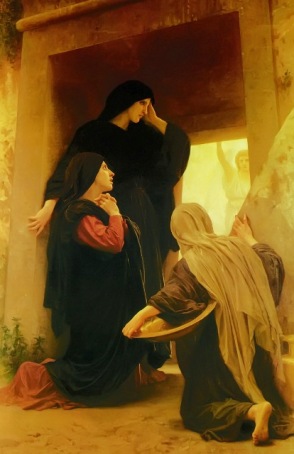 The women were horrified by the loss of Jesus’ body, and dazed by the alternative possibility that he was alive. They were sensible peasant women, not given to flights of fancy. The idea that someone could be dead and then not dead must have seemed utterly incredible. They knew it would certainly seem so to anyone who heard about it. What did ‘risen’ mean? Who would believe them when they described their experience?
The women were horrified by the loss of Jesus’ body, and dazed by the alternative possibility that he was alive. They were sensible peasant women, not given to flights of fancy. The idea that someone could be dead and then not dead must have seemed utterly incredible. They knew it would certainly seem so to anyone who heard about it. What did ‘risen’ mean? Who would believe them when they described their experience?
At the same time the women were elated, and ran back to the house where they were staying, where many of Jesus’ disciples had gathered. They offered hope in place of despair. Mark’s gospel says they told no-one, but presumably this means no-one other than the disciples.
They were greeted with disbelief. This was surely a fantasy dreamed up by hysterical women, the disciples reasoned. Women’s testimony was not given the same weight in a court of law as men’s was, and no doubt the male disciples thought at this moment it was a good idea that it should be so.
Read the red Gospel text at bottom of page
Return to top
What the Gospels say
1. Why did they go? Read the blue text
2. What did they find? Read the green text
3. What did they do? Read the red text
Matthew 28:1-10
1 Now after the Sabbath, toward the dawn of the first day of the week, Mary Magdalene and the other Mary went to see the sepulchre.
2 And behold, there was a great earthquake; for an angel of the Lord descended from heaven and came and rolled back the stone, and sat upon it. 3 His appearance was like lightning, and his raiment white as snow. 4 And for fear of him the guards trembled and became like dead men. 5 But the angel said to the women, “Do not be afraid; for I know that you seek Jesus who was crucified. 6 He is not here; for he has risen, as he said. Come, see the place where he lay. 7 Then go quickly and tell his disciples that he has risen from the dead, and behold, he is going before you to Galilee; there you will see him. Lo, I have told you.”
8 So they departed quickly from the tomb with fear and great joy, and ran to tell his disciples.Events in the life of Jesus Christ 9 And behold, Jesus met them and said, “Hail!” And they came up and took hold of his feet and worshiped him. 10 Then Jesus said to them, “Do not be afraid; go and tell my brothers to go to Galilee, and there they will see me.”
Mark 16:1-8
1 And when the Sabbath was past, Mary Magdalene, and Mary the mother of James, and Salome, bought spices, so that they might go and anoint him.
2 And very early on the first day of the week they went to the tomb when the sun had risen. 3 And they were saying to one another, “Who will roll away the stone for us from the door of the tomb?” 4 And looking up, they saw that the stone was rolled back; –it was very large. 5 And entering the tomb, they saw a young man sitting on the right side, dressed in a white robe; and they were amazed. 6 And he said to them, “Do not be amazed; you seek Jesus of Nazareth, who was crucified. He has risen, he is not here; see the place where they laid him. 7 But go, tell his disciples and Peter that he is going before you to Galilee; there you will see him, as he told you.”
8 And they went out and fled from the tomb; for trembling and astonishment had come upon them; and they said nothing to any one, for they were afraid.
Luke 24:1-11
1 But on the first day of the week, at early dawn, they went to the tomb, taking the spices which they had prepared.
2 And they found the stone rolled away from the tomb, 3 but when they went in they did not find the body. 4 While they were perplexed about this, behold, two men stood by them in dazzling apparel; 5 and as they were frightened and bowed their faces to the ground, the men said to them, “Why do you seek the living among the dead? 6 Remember how he told you, while he was still in Galilee, 7 that the Son of man must be delivered into the hands of sinful men, and be crucified, and on the third day rise.”
8 And they remembered his words, 9 and returning from the tomb they told all this to the eleven and to all the rest. 10 Now it was Mary Magdalene and Joanna and Mary the mother of James and the other women with them who told this to the apostles; 11 but these words seemed to them an idle tale, and they did not believe them.
You might like to compare the parallel accounts of the births of Jesus and John the Baptist in Luke’s gospel. You can find the gospel texts at http://www.womeninthebible.net/Elizabeth_bible_text.htm
Notice especially statements about
the pregnancy reaching term, Luke 1.57 and 2.6
the birth statement, Luke 1.57 and 2.7
marvelling onlookers, Luke 1.63 and 2.18
the taking to heart of what had happened, Luke 1.66 and 2.19
circumcision and name-giving, Luke 1.59 and 2.21
John’s birth is clearly a prelude to the birth of Jesus.

